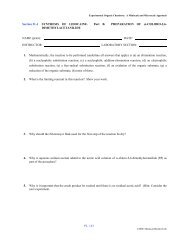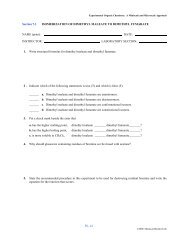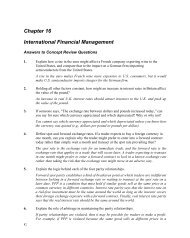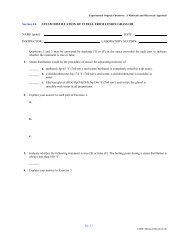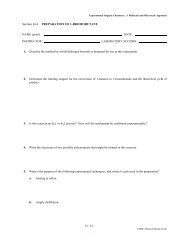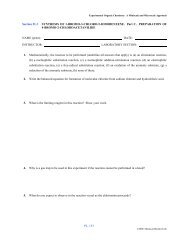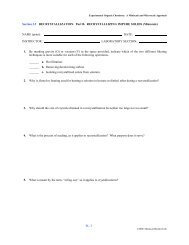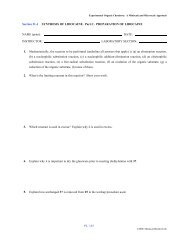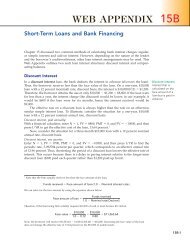Appendix 1: Labor Unions and Collective Bargaining
Appendix 1: Labor Unions and Collective Bargaining
Appendix 1: Labor Unions and Collective Bargaining
You also want an ePaper? Increase the reach of your titles
YUMPU automatically turns print PDFs into web optimized ePapers that Google loves.
e surprising that the provisions of all three were largely<br />
favorable to unions.<br />
By far the most important labor law enacted during<br />
the 1930s was the National <strong>Labor</strong> Relations Act<br />
of 1935 (NLRA), also known as the Wagner Act. The<br />
NLRA prevented employers from discriminating against<br />
union workers in hiring or employment practices <strong>and</strong><br />
required employers to bargain in good faith with unions.<br />
It also established the National <strong>Labor</strong> Relations Board to<br />
investigate claims of unfair labor practices. The passage<br />
of the NLRA gave a tremendous boost to the labor movement.<br />
Union membership increased from 3.5 million<br />
workers in 1935 to 10.2 million in 1941. 1<br />
Immediately after World War II, unions began to<br />
flex their newfound strength. In the first six months<br />
of 1946, almost 3 million union workers went out on<br />
strike—including 750,000 steelworkers, in what remains<br />
the largest single strike in U.S. history. This series of<br />
strikes created serious disruptions to the U.S. economy<br />
<strong>and</strong> caused many people to fear that big labor had<br />
become too powerful. In response to these concerns,<br />
Congress passed the <strong>Labor</strong>–Management Relations<br />
Act of 1947 (usually called the Taft–Hartley Act). The<br />
Taft–Hartley Act placed limits on unions much as the<br />
Wagner Act had placed limits on employers. 2<br />
Prior to Taft–Hartley, many unions were able to get<br />
closed shop <strong>and</strong> union shop clauses included in their<br />
contracts. Under a closed shop workers must belong<br />
to the union before the employer can hire them. The<br />
Taft–Hartley Act made closed shops illegal. In a union<br />
shop, employers can hire workers who don’t belong<br />
to the union, but nonunion workers must join the union<br />
within a specified period in order to keep their jobs. The<br />
Taft–Hartley Act didn’t declare the union shop illegal, but<br />
it did allow each state to enact a right-to-work law<br />
that made union shops illegal within its borders.<br />
Twenty-two states have passed right-to-work laws,<br />
including every state in the South <strong>and</strong> many in the Great<br />
Exhibit A1.2<br />
Washington<br />
California<br />
Alaska<br />
Oregon<br />
Nevada<br />
Hawaii<br />
Montana N. Dakota<br />
Minn.<br />
Idaho<br />
S. Dakota Wisc.<br />
Wyoming<br />
Utah<br />
Arizona<br />
Right to Work State<br />
Forced-Unionism State<br />
Twenty-two states have adopted<br />
right-to-work laws declaring union<br />
shops illegal.<br />
Colorado<br />
New<br />
Mexico<br />
Nebraska<br />
Kansas<br />
Texas<br />
Okla.<br />
Iowa<br />
Mo.<br />
Ark.<br />
Ill.<br />
Ala. Miss.<br />
Louisiana<br />
Ind. Ohio W.V.<br />
Ky.<br />
Tenn.<br />
Michigan<br />
Florida<br />
N.Y.<br />
Penn.<br />
N.H.<br />
Vt.<br />
South Carolina<br />
Georgia<br />
Plains <strong>and</strong> West. In these states,<br />
workers who are represented by a<br />
union don’t have to join that union.<br />
In this situation, known as an open<br />
shop, nonunion workers receive<br />
the same wages <strong>and</strong> benefits as<br />
their union counterparts. Exhibit<br />
A1.2 shows the states that have<br />
adopted right to work laws.<br />
Supporters of right-to-work<br />
laws argue that workers shouldn’t<br />
be forced to join a union in order<br />
to keep their jobs—especially since<br />
the union might use strategies or<br />
adopt positions that are inconsistent<br />
with their personal values. But critics<br />
of these laws point out that they<br />
allow workers to receive the benefits<br />
of union representation without<br />
paying union dues, creating what<br />
union supporters call the free rider<br />
problem. Getting union benefits<br />
without paying dues might seem<br />
like a good deal to individual workers;<br />
however, if too many workers<br />
become free riders the union will<br />
lack the financial resources <strong>and</strong><br />
unity it needs to effectively represent<br />
these workers.<br />
LO3 <strong>Collective</strong><br />
<strong>Bargaining</strong>:<br />
Reaching an<br />
Agreement<br />
Maine<br />
Mass.<br />
R.I.<br />
Conn.<br />
N.J.<br />
Delaware<br />
Maryl<strong>and</strong><br />
Virginia<br />
North Carolina<br />
<strong>Collective</strong> bargaining is the<br />
process by which representatives<br />
of labor <strong>and</strong> management<br />
attempt to negotiate a mutually<br />
acceptable labor agreement.<br />
Federal law requires<br />
that both sides in this process<br />
bargain in good faith,<br />
meaning that they must<br />
take the process seriously<br />
<strong>and</strong> make a sincere effort to<br />
reach an agreement that is<br />
acceptable to both sides.<br />
National <strong>Labor</strong><br />
Relations Act<br />
(Wagner Act)<br />
L<strong>and</strong>mark pro-labor<br />
law enacted in 1935.<br />
This law made it<br />
illegal for firms to<br />
discriminate against<br />
union members <strong>and</strong><br />
required employers<br />
to recognize<br />
certified unions <strong>and</strong><br />
bargain with these<br />
unions in good faith.<br />
<strong>Labor</strong>–Management<br />
Relations Act<br />
(Taft–Hartley Act)<br />
Act passed in 1947<br />
that placed limits<br />
on union activities,<br />
outlawing the closed<br />
shop <strong>and</strong> allowing<br />
states to pass rightto-work<br />
laws that<br />
made union shops<br />
illegal.<br />
closed shop An<br />
employment<br />
arrangement in<br />
which the employer<br />
agrees to hire<br />
only workers who<br />
already belong to<br />
the union.<br />
union shop An<br />
employment<br />
arrangement in<br />
which a firm can<br />
hire nonunion<br />
workers, but these<br />
workers must join<br />
the union within a<br />
specified time period<br />
to keep their jobs.<br />
right-to-work law<br />
A state law that<br />
makes union shops<br />
illegal within that<br />
state’s borders.<br />
open shop An<br />
employment<br />
arrangement in<br />
which workers who<br />
are represented<br />
by a union are not<br />
required to join the<br />
union or pay union<br />
dues.<br />
collective<br />
bargaining The<br />
process by which<br />
representatives of<br />
union members <strong>and</strong><br />
employers attempt<br />
to negotiate a<br />
mutually acceptable<br />
labor agreement.<br />
Subjects of <strong>Bargaining</strong>:<br />
What It’s All About<br />
There is no set list of topics that are always<br />
discussed during collective bargaining, but under<br />
federal labor law certain subjects are m<strong>and</strong>atory<br />
subjects of bargaining. M<strong>and</strong>atory topics are<br />
those that deal with wages <strong>and</strong> benefits, hours of<br />
work, <strong>and</strong> other terms directly related to working<br />
conditions. If one side makes a proposal covering<br />
<strong>Appendix</strong> 1 <strong>Labor</strong> <strong>Unions</strong> <strong>and</strong> <strong>Collective</strong> <strong>Bargaining</strong> A1-5<br />
69890_22_ap1.indd A1-5<br />
11/20/07 3:53:16 PM




